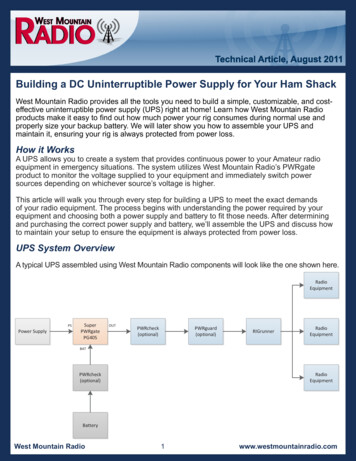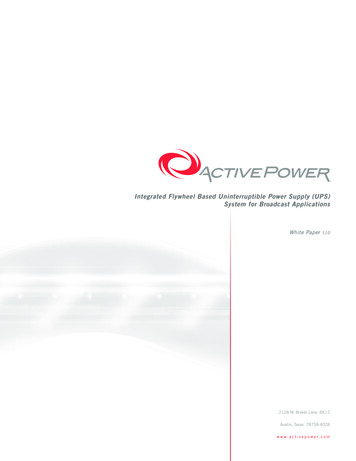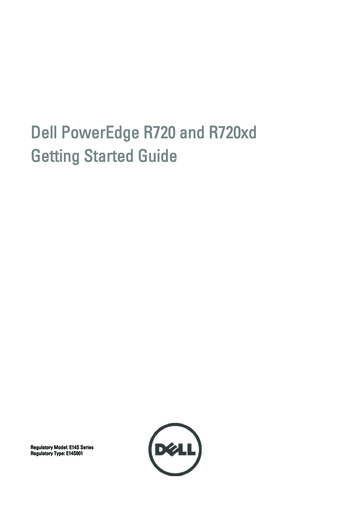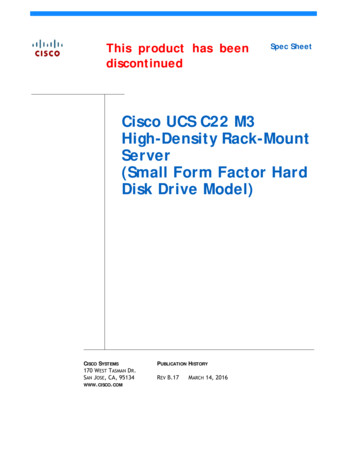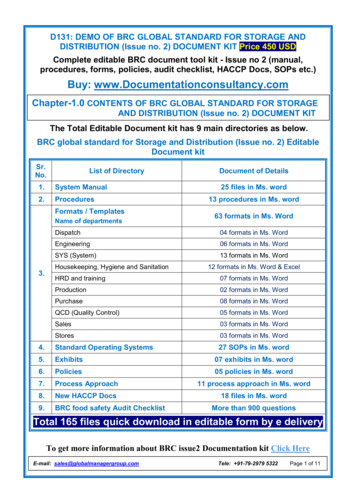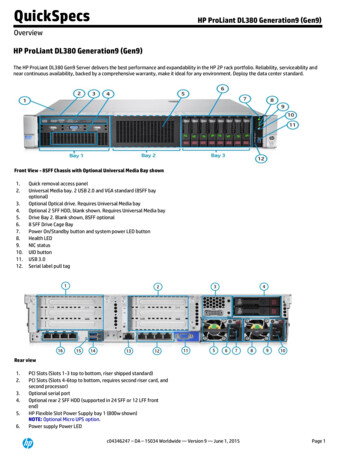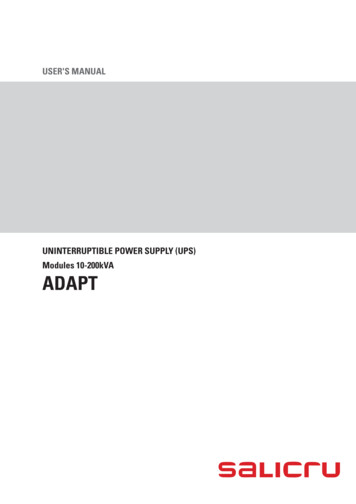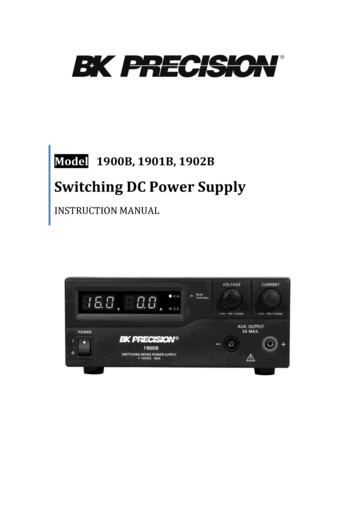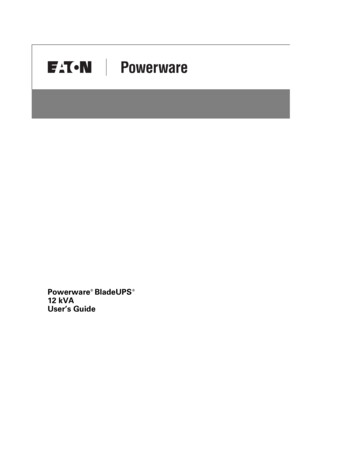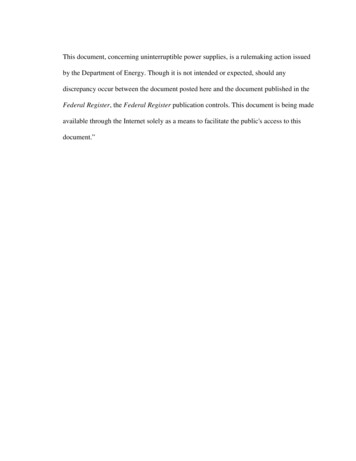
Transcription
This document, concerning uninterruptible power supplies, is a rulemaking action issuedby the Department of Energy. Though it is not intended or expected, should anydiscrepancy occur between the document posted here and the document published in theFederal Register, the Federal Register publication controls. This document is being madeavailable through the Internet solely as a means to facilitate the public's access to thisdocument.”
[6450-01-P]DEPARTMENT OF ENERGYOffice of Energy Efficiency and Renewable Energy10 CFR Parts 429 and 430[Docket No. EERE-2016-BT-TP-0018]RIN: 1904-AD68Energy Conservation Program: Test Procedure for Uninterruptible Power SuppliesAGENCY: Office of Energy Efficiency and Renewable Energy, Department of Energy.ACTION: Notice of proposed rulemaking.SUMMARY: The U.S. Department of Energy (DOE) is proposing to revise its battery chargertest procedure established under the Energy Policy and Conservation Act of 1975, as amended. Theseproposed revisions, if adopted, will add a discrete test procedure for uninterruptible power supplies(UPSs) to the current battery charger test procedure.DATES: Meeting: DOE will hold a public meeting on Thursday, June 9, 2016, from 9:30 a.m. to12:30 p.m., in Washington, DC. The meeting will also be broadcast as a webinar. See section V,“Public Participation,” for webinar registration information, participant instructions, and informationabout the capabilities available to webinar participants.1
Comments: DOE will accept comments, data, and information regarding this notice of proposedrulemaking (NOPR) before and after the public meeting, but no later than [INSERT DATE 60 DAYSAFTER FEDERAL REGISTER PUBLICATION]. See section V, “Public Participation,” for details.ADDRESSES: The public meeting will be held at the U.S. Department of Energy, Forrestal Building,Room 8E-089, 1000 Independence Avenue, SW., Washington, DC 20585.Any comments submitted must identify the NOPR for Test Procedure for Battery Chargers, andprovide docket number EE-2016–BT–TP–0018 and/or regulatory information number (RIN) number1904-AD68. Comments may be submitted using any of the following methods:1.Federal eRulemaking Portal: www.regulations.gov. Follow the instructions for submittingcomments.2.E-mail: UPS2016TP0018@ee.doe.gov. Include the docket number and/or RIN in the subject lineof the message.3.Mail: Ms. Brenda Edwards, U.S. Department of Energy, Building Technologies Office, MailstopEE-2J, 1000 Independence Avenue, SW., Washington, DC, 20585-0121. If possible, pleasesubmit all items on a CD, in which case it is not necessary to include printed copies.4.Hand Delivery/Courier: Ms. Brenda Edwards, U.S. Department of Energy, BuildingTechnologies Office, 950 L’Enfant Plaza, SW., Suite 600, Washington, DC, 20024. Telephone:(202) 586-2945. If possible, please submit all items on a CD, in which case it is not necessary toinclude printed copies.2
For detailed instructions on submitting comments and additional information on the rulemakingprocess, see section V of this document (Public Participation).Docket: The docket, which includes Federal Register notices, public meeting attendeelists and transcripts, comments, and other supporting documents/materials, is available for review athttp://www.regulations.gov/#!docketDetail;D EERE-2016-BT-TP-0018. All documents in the docketare listed in the www.regulations.gov index. However, some documents listed in the index, such asthose containing information that is exempt from public disclosure, may not be publicly available. Thewww.regulations.gov web page contains simple instructions on how to access all documents, includingpublic comments, in the docket. See section V for information on how to submit comments throughwww.regulations.gov.FOR FURTHER INFORMATION CONTACT:Jeremy Dommu, U.S. Department of Energy, Office of Energy Efficiency and RenewableEnergy, Building Technologies Office, EE-5B, 1000 Independence Avenue, SW., Washington, DC,20585-0121. Telephone: (202) 586-9870. E-mail:battery chargers and external power supplies@ee.doe.govIn the Office of the General Counsel, contact Mr. Pete Cochran, U.S. Department of Energy,Office of the General Counsel, GC-33, 1000 Independence Avenue, SW., Washington, DC, 20585-0121.Telephone: (202) 586–9496. E-mail: peter.cochran@hq.doe.gov.3
For further information on how to submit a comment, review other public comments and thedocket, or participate in the public meeting, contact Ms. Brenda Edwards at (202) 586-2945 or by email:Brenda.Edwards@ee.doe.gov.SUPPLEMENTARY INFORMATION:This proposed rule would incorporate by reference into 10 CFR part 430 the testing methodscontained in the following commercial standard:IEC 62040-3, “Uninterruptible power systems (UPS) – Method of specifying the performanceand test requirements,” Edition 2.0, Section 6 “UPS tests,” and Annex J “UPS efficiency – Methods ofmeasurement.”Copies of the IEC 62040-3 Ed. 2.0 standard are available from the American National StandardsInstitute, 25 W. 43rd Street, 4th Floor, New York, NY 10036 or at http://webstore.ansi.org/.Table of ContentsI. Authority and BackgroundII. Summary of the Notice of Proposed RulemakingIII. DiscussionA. Covered Products and ScopeB. Existing Test Procedures and Standards Incorporated by ReferenceC. Definitions1. Energy Storage System2. Normal Mode3. Reference Test Load4. Uninterruptible Power SuppliesD. Test Conditions1. Accuracy and Precision of Measuring Equipment2. Environmental Conditions4
3. Input Voltage and FrequencyE. Battery ConfigurationF. Product ConfigurationG. Average Power and Efficiency Calculation1. Average Power2. EfficiencyH. Output MetricI. Effective Date and Compliance of Test ProcedureJ. Sampling Plan for Determination of Certified RatingK. Certification ReportsIV. Procedural Issues and Regulatory ReviewA. Review Under Executive Order 12866B. Review under the Regulatory Flexibility ActC. Review Under the Paperwork Reduction Act of 1995D. Review Under the National Environmental Policy Act of 1969E. Review Under Executive Order 13132F. Review Under Executive Order 12988G. Review Under the Unfunded Mandates Reform Act of 1995H. Review Under the Treasury and General Government Appropriations Act, 1999I. Review Under Executive Order 12630J. Review Under Treasury and General Government Appropriations Act, 2001K. Review Under Executive Order 13211L. Review Under Section 32 of the Federal Energy Administration Act of 1974M. Description of Material Incorporated by ReferenceV. Public ParticipationA. Attendance at Public MeetingB. Procedure for Submitting Prepared General Statements for DistributionC. Conduct of Public MeetingD. Submission of CommentsE. Issues on Which DOE Seeks CommentVI. Approval of the Office of the SecretaryI. Authority and Background5
Title III of the Energy Policy and Conservation Act of 1975 (42 U.S.C. 6291, et seq.; “EPCA”or, “the Act”) sets forth a variety of provisions designed to improve energy efficiency. 1 Part B 2 of titleIII, established the “Energy Conservation Program for Consumer Products Other Than Automobiles.”Battery chargers are among the consumer products affected by these provisions. (42 U.S.C. 6295(u))Under EPCA, the energy conservation program consists essentially of four parts: (1) testing, (2)labeling, (3) Federal energy conservation standards, and (4) certification and enforcement procedures.The testing requirements consist of test procedures that manufacturers of covered products must use asthe basis for (1) certifying to DOE that their products comply with the applicable energy conservationstandards adopted under EPCA, and (2) making representations about the efficiency of those products.Similarly, DOE must use these test procedures to determine whether the products comply with anyrelevant standards promulgated under EPCA.General Test Procedure Rulemaking ProcessUnder 42 U.S.C. 6293, EPCA sets forth the criteria and procedures DOE must follow whenprescribing or amending test procedures for covered products. EPCA provides in relevant part that anytest procedures prescribed or amended under this section shall be reasonably designed to produce testresults which measure energy efficiency, energy use or estimated annual operating cost of a coveredproduct during a representative average use cycle or period of use and shall not be unduly burdensometo conduct. (42 U.S.C. 6293(b)(3))1All references to EPCA refer to the statute as amended through the Energy Efficiency Improvement Act, Public Law 114-11(April 30, 2015).2For editorial reasons, Part B was redesignated as Part A upon incorporation into the U.S. Code (42 U.S.C. 6291–6309, ascodified).6
In addition, if DOE determines that a test procedure amendment is warranted, it must publishproposed test procedures and offer the public an opportunity to present oral and written comments onthem. (42 U.S.C. 6293(b)(2)) Finally, in any rulemaking to amend a test procedure, DOE mustdetermine to what extent, if any, the proposed test procedure would alter the measured energy efficiencyof any covered product as determined under the existing test procedure. (42 U.S.C. 6293(e)(1))BackgroundThe “Uniform Test Method for Measuring the Energy Consumption of Battery Chargers” inappendix Y to subpart B of 10 CFR part 430 specifies the testing requirements for battery chargers.DOE last amended this test method with the publication of a test procedure final rule on June 1, 2011,which codified a new active-mode test procedure and amended the existing standby and off-mode testprocedures. 76 FR 31750. As federal standards for battery chargers have yet to be finalized, DOE hasnot required manufacturers to submit energy efficiency data for their products tested under the batterycharger test procedure.DOE published a notice of proposed rulemaking (NOPR) on March 27, 2012, regarding energyconservation standards for battery chargers and external power supplies (March 2012 NOPR) where itproposed standards for battery chargers, including uninterruptible power supplies (UPSs). 77 FR 18478Following the publication of the 2011 battery charger test procedure final rule and the March2012 NOPR, DOE explored whether to regulate UPSs as “computer systems.” See, e.g., 79 FR 11345(Feb. 28, 2014) (proposed coverage determination); 79 FR 41656 (July 17, 2014) (computer systemsframework document). DOE received a number of comments in response to those documents (and the7
related public meetings) regarding testing of UPSs, which are discussed in this NOPR. At the sametime, DOE received questions and requests for clarification regarding the testing, rating, andclassification of battery chargers.As part of the continuing effort to establish federal efficiency standards for battery chargers andto develop a clear and widely applicable test procedure, DOE published a notice of data availability(May 2014 NODA) on May 15, 2014. 79 FR 27774. This NODA sought comments from stakeholdersconcerning the repeatability of the test procedure when testing battery chargers with several consumerconfigurations and on the future market penetration of new battery charging technologies that mayrequire revisions to the battery charger test procedure. DOE also sought comments on the reportingrequirements for manufacturers attempting to comply with the California Energy Commission’s (CEC’s)efficiency standards for battery chargers in order to understand certain data discrepancies in the CECdatabase. These issues were discussed during DOE’s NODA public meeting on June 3, 2014.Based upon discussions from the May 2014 NODA public meeting and written commentssubmitted by various stakeholders, DOE published a NOPR (August 2015 NOPR) to revise the currentbattery charger test procedure on August 6, 2015. 80 FR 46855. DOE received a number of stakeholdercomments on the August 2015 NOPR and the computer systems framework document regardingregulation of battery chargers including UPSs. After considering these comments, DOE reconsidered itsposition and found that since a UPS meets the definition of a battery charger, it is more appropriate toregulate UPSs as part of the battery charger rulemaking. Therefore, in today’s notice DOE proposes toamend the battery charger test procedure to include specific test provisions for UPSs.8
II. Summary of the Notice of Proposed RulemakingThis proposal seeks to add provisions for testing UPSs to the battery charger test procedure.Specifically, DOE is proposing to incorporate by reference specific sections of IEC 62040-3 Ed 2.0 withadditional instructions, into the current battery charger test procedure published at appendix Y to subpartB of 10 CFR part 430.Additionally, this proposal seeks to add formal definitions for uninterruptiblepower supply, voltage and frequency dependent UPSs, voltage independent UPSs, voltage andfrequency independent UPSs, energy storage systems, normal mode and reference test load to appendixY to subpart B of 10 CFR part 430 and revise the compliance certification requirements for batterychargers published at 10 CFR 429.39.III. DiscussionIn response to the August 2015 NOPR, DOE received written comments from 18 interestedparties, including manufacturers, trade associations, standards development organizations and energyefficiency advocacy groups. Table III-1 below lists only the entities that commented on the proposedexclusion of UPSs, as battery chargers. These comments are discussed in further detail below. The fullset of comments on the battery charger test procedure NOPR can be found at:http://www.regulations.gov/#!docketBrowser;rpp 25;po 0;dct PS;D EERE-2014-BT-TP-0044Table III-1 Interested Parties That Provided Written Comments on Proposed Exclusion of UPSsas Battery Chargers in the August 2015 NOPRCommentOrganizationCommenterAcronymNo. (DocketType/AffiliationReference)California Investor OwnedCA IOUsUtility Association21Utilities9
Natural Resources DefenseCouncil, Appliance StandardsAwareness Project, andNorthwest Energy EfficiencyAllianceSchneider ElectricNRDC,ASAP, andNEEAEnergy Efficiency ilarly, in response to the computer systems framework document, DOE received writtencomments from 9 interested parties, including manufacturers, trade associations, standards developmentorganizations, and energy efficiency advocacy groups. Table III-2 below lists only the entities thatcommented on the inclusion of UPSs in the computer systems rulemaking. These comments are alsodiscussed in detail below. The full set of comments on the computer systems framework document canbe found at: http://www.regulations.gov/#!docketBrowser;rpp 25;po 0;dct PS;D EERE-2014-BTSTD-0025Table III-2 Interested Parties That Provided Written Comments on the Inclusion of UPSs in theComputer Systems Framework DocumentOrganizationComment No.CommenterAcronymType/Affiliation(Docket Reference)InformationITITrade Association10Technology IndustryCouncilNational ElectricalNEMATrade Association15ManufacturersAssociationSchneider ElectricSchneider ElectricManufacturer08A. Covered Products and ScopeDOE has proposed several different methods of handling UPSs throughout the course of thebattery chargers and computer systems rulemakings. Originally, DOE had proposed energy10
conservation standards for UPSs as part of the 2012 battery chargers NOPR. DOE proposed that UPSsbe part of product class 10a and 10b and be regulated using the same energy consumption metric (annualunit energy consumption or “UEC”) and test procedure as all other battery chargers, using a usageprofile assumption for those product classes that is typical of UPSs. 77 FR 18478. However, in 2014,DOE proposed that UPSs be included as part of the proposed coverage determination for computersystems. As outlined in the computer systems framework document, DOE sought stakeholder feedbackof its consideration of referencing IEC 62040-3 Edition 2.0, “Uninterruptible power systems (UPS) –Method of specifying the performance and test requirements”, March 2011 (IEC 62040-3 Ed. 2.0), asthe test procedure for UPSs with the inclusion of additional instructions from ENERGY STAR UPSVersion 1.0, “ENERGY STAR Program Requirements for Uninterruptible Power Supplies,” Rev. July2012 (ENERGY STAR UPS V. 1.0). This test procedure would measure the average conversionefficiency of a UPS with test loads connected to the UPS.DOE received comments on the battery charger test procedure NOPR from Schneider Electricand the CA IOUs opposing the exclusion of UPSs from the scope of the battery charger test procedure.These stakeholders highlighted the usage of the current battery charger test procedure by CEC toregulate UPSs under the state’s own battery charger energy conservation program. (Docket No. EERE2014-BT-TP-0044, Schneider Electric, No, 12 at p. 1, Docket No. EERE-2014-BT-TP-0044, CA IOUs,No. 21 at p. 3) Their comments emphasize that UPSs are a type of backup battery charger and shouldremain in the scope of the battery charger test procedure. Similarly, NRDC, ASAP, and NEEAsubmitted comments recommending that battery backup systems be included in the scope of the batterycharger test procedure. Further, NRDC, ASAP, and NEEA recommended that DOE exclude batterybackup systems as a covered product in order to allow the CEC to continue to enforce its standards for11
these products until the computer systems standards become effective. (Docket No. EERE-2014-BTTP-0044, NRDC, ASAP, and NEEA, No. 20, p. 2)After considering all related stakeholder comments, DOE believes that it is most appropriate toinclude UPSs within the scope of the battery charger test procedure. Although UPSs may providevarious types of power conditioning and monitoring functionality depending on their architecture andinput dependency, they primarily maintain the fully-charged state of lead acid batteries with relativelyhigh self-discharge rates so that in the event of a power outage, they are able to provide backup powerinstantly to the connected load. Maintaining the lead acid battery therefore directly affects a UPS’soverall energy efficiency. In 10 CFR 430.2, a battery charger is defined as a device that chargesbatteries for consumer products. Because UPSs that are in scope of this rulemaking have the primarytask of maintaining a charged lead acid battery, DOE concludes that UPSs meet the definition of abattery charger and, as such, should be considered within the scope of the battery charger test procedure.UPSs are defined in IEC 62040-3 Ed. 2.0 as a combination of convertors, switches and energystorage devices (such as batteries), constituting a power system for maintaining continuity of load powerin case of input power failure. Today, DOE proposes to adopt this definition for UPSs; that is, onlybattery chargers that meet the above-stated definition of a UPS are subject to the testing requirementsproposed in this NOPR. While UPSs with a variety of architectures, input dependency and input/outputcharacteristics may meet IEC’s definition, DOE is further proposing to limit the applicability of this testprocedure to only those that have an AC output to help limit the scope of the UPS test procedure. DOEemphasizes that this proposal to include specific test provisions for UPSs in the battery charger test12
procedure only applies to products that meet the above stated definition of a UPS and have an ACoutput.DOE requests comment on the proposal to include specific test provisions for UPSs, as definedabove, in the battery charger test procedure.B. Existing Test Procedures and Standards Incorporated by ReferenceDOE is proposing to add specific testing provisions for UPSs in the battery charger testprocedure, as the Department believes that the specifications in the current battery charger testprocedure are not appropriate for UPSs. Most battery chargers have four modes of operation: (1) activemode (charging batteries that are at various stages of depletion); (2) maintenance mode (maintainingfully charged batteries); (3) standby mode (plugged in with no battery connected to charge and allmanual on-off switches turned on); and (4) off mode (plugged in with no battery connected to chargeand all manual on-off switches turned off). The current battery charger test procedure measures energyconsumption in these modes because most battery chargers generally spend a significant amount of timein all four modes of operation. Most battery chargers are used to charge the batteries of products that aredesigned to be regularly operated using battery power. This makes the current test procedure outputmetrics appropriate for representing the energy consumption of most kinds of battery chargers during arepresentative average use cycle.In contrast, the current test procedure, which measures energy consumption of a battery chargeras it charges a fully discharged battery, is inappropriate for a UPS since a UPS rarely has a fullydischarged battery. The UPS’s battery is only infrequently depleted during a power outage when a13
connected load discharges the energy stored within the UPS’s battery in order to continue normaloperation of the powered product. Likewise, it is only after power has been restored following anoutage that the UPS charges depleted batteries. The vast majority of the time a UPS provides a smallamount of charge necessary to maintain fully charged batteries and also delivers power to a connectedload. Therefore, in order to accurately capture the energy consumption and energy efficiency of thenormal operation of a UPS, the test procedure should measure the energy consumption of maintaining afully charged battery and the conversion losses associated with delivering load power.The following subsections discuss each mode of operation that is currently included within theDOE battery charger test procedure, and the rationale for why each mode is not applicable to UPSs.1. Active mode: Section 2.1 of appendix Y to subpart B of 10 CFR part 430 defines activemode or charge mode as a state in which the battery charger system is connected to the mainelectricity supply, and the battery charger is delivering current, equalizing cells, andperforming other one-time or limited-time functions in order to bring the battery to a fullycharged state. In active mode, the battery charger is charging a battery that is partially orfully discharged. However, unlike other battery chargers, UPSs seldom have a fullydischarged battery. UPSs primarily maintain the fully-charged state of their internal batteriesso that in the event of a power outage, the internal batteries are able to instantly providebackup power to a connected load. However, power outages are infrequent in the UnitedStates and therefore a UPS rarely switches to backup power and consumes its stored energy.Because the battery is maintained in a fully charged state during the majority of a UPS’sservice life, UPSs are almost never required to enter active mode to replenish a depleted14
battery. Consequently, it would not be appropriate to measure the active mode energyconsumption of a UPS by the current battery charger test procedure because the resultingmeasured energy would not be representative for a UPS in typical use as required by 42U.S.C. 6293(b)(3). Two other outputs of the current test procedure, battery capacity andcharge time, are related to measuring the energy consumption in active mode. Because theactive mode is generally not common for a UPS, measuring battery capacity and charge timewould typically not be representative.2. Maintenance mode: Once the batteries have been fully charged, a battery charger typicallyenters a maintenance mode intended to maintain the fully charged state of batteries with afinite self-discharge rate, while protecting it from overcharging. Although UPSs spend themajority of their service life in this mode, UPSs also continuously provide power to aconnected load. This aspect is missing from the current battery charger test procedure, whichdoes not require a load to be connected to the battery charger – only to a battery. UPSs arealmost always connected to a load, such as a computer, because the primary purpose of aUPS is to provide power in the event of an unexpected power outage. Leaving the UPSunconnected to a load would not be representative of typical usage, and the resultingmeasured energy consumption would not be representative, as required by 42 U.S.C.6293(b)(3).3. Standby and off modes: The current battery charger test procedure requires that, in additionto active and maintenance mode, a battery charger’s energy consumption be measured in twoother modes of operation; standby and off mode. In standby mode, the battery charger15
remains connected to the main electricity supply with the battery itself disconnected and allmanual on-off switches (if applicable) turned on. In off mode, the battery charger remainsconnected to the main electricity supply with the battery itself disconnected and all manualon-off switches (if applicable) turned off. UPSs never experience these modes of operationin typical use since they are always connected to mains power and have batteries attached inorder to service their loads in the event of a power outage. Therefore, testing UPSs instandby and off modes would not be representative of typical usage, and the resultingmeasured energy consumption would not be representative, as required by 42 U.S.C.6293(b)(3).As each of the modes of operation discussed above is not directly applicable to UPSs, DOEproposes to amend the current battery charger test procedure to add auxiliary instructions for testing aUPS that will better capture the device’s real world energy performance. More specifically, DOEproposes to define “normal mode” as a mode of operation where the UPS maintains a battery whilesimultaneously powering a connected load.In order to measure energy consumption during normal mode, DOE proposes to incorporate byreference Section 6 and Annex J of IEC 62040-3 Ed. 2.0 in the battery charger test procedure. This testmethod requires that power consumption of a UPS be measured in normal mode with reference testloads equal to 25%, 50%, 75%, and 100% of the unit’s rated power. Each of these individual efficiencydata points is then weighted by a coefficient that is specific for each UPS architecture and combined todetermine the overall average efficiency of the unit. DOE is aware that the IEC standard is underrevision and will consider amending this test procedure to further harmonize with any finalized revision16
of this industry test procedure. Furthermore, DOE proposes to include additional instructions, some ofwhich are provided in the ENERGY STAR UPS V. 1.0 specification. Discussion of these additionalinstructions is found in sections III.C and III.D of this notice.DOE requests stakeholder comments on the type of changes that are being considered for therevised IEC 62040-3 standard and how it may impact the test procedure proposed today.Because DOE is proposing to adopt testing requirements for UPSs from IEC 62040-2 Ed. 2.0with additional instructions where appropriate, the following sections discuss these proposedrequirements including definitions, test conditions, battery and product configuration, average powerand efficiency calculations, output metric, effective date and compliance requirements, sampling planand certification reports.C. DefinitionsDOE proposes to include the following definitions, in alphabetical order, in section 2 ofappendix Y to subpart B of 10 CFR part 430. DOE requests comment on all proposed definitions,particularly those that are not defined in existing industry standards.1. Energy Storage SystemDOE proposes the following definition for an Energy Storage System of a UPS:“Energy storage system is a system consisting of single or multiple devices designed to providepower to the UPS inverter circuitry.”17
2. Normal ModeNormal mode for UPSs is similar to the maintenance mode of other battery chargers as definedin appendix Y to subpart B of 10 CFR part 430 in that the UPS maintains the fully charged state ofbatteries with a finite self-discharge rate, while protecting it from overcharging. However, in addition tomaintaining a battery, a UPS in normal mode also continuously provides power to a load. In order tohighlight this distinction, DOE proposes the following definition for the normal mode of operation for aUPS.“Normal mode is a mode of operation for a UPS in which:(i) The UPS provides required output power to the connected load without switching to batterypower,(ii) the energy storage system is being maintained at full charge, and (iii) the load connected tothe UPS is within the UPS’s specified power rating.”3. Reference Test LoadTo describe the load that is used for testing UPSs, DOE proposes the following definition forreference test load.“Reference test load is a load or condition with a power factor of greater than 0.99 in which theAC output socket of the UPS delivers the active power (W) for which the UPS is rated.”18
While IEC 62040-3 Ed. 2.0 also provides a definition for reference test load, it does notexplicitly address whether such a test load is linear or non-linear in nature. Similarly, section 4.2 ofENERGY STAR UPS V. 1.0 calls for the reference test load to be resistive without clearly defining theterm ‘resistive’. DOE’s proposed definition properly characterizes the test load to be used for UPStesting and removes ambiguity by requiring the test load to be linear and resistive through the powerfactor requirement.4. Uninterruptible Power SuppliesDOE proposes the following definition for a UPS:“Uninterruptible power supply or UPS means a battery charger consisting of a combination ofconvertors, switches and energy storage devices, constituting a power system for maintaining continuityof load power in case of input power failure.”DOE is also proposing to include definitions for voltage independent, voltage
DOE last amended this test method with the publication of a test procedure final rule on June 1, 2011, which codified a new active-mode test procedure and amended the existing standby and off-mode test procedures. 76 FR 31750. As federal standards for battery chargers have yet to be finalized, DOE has
